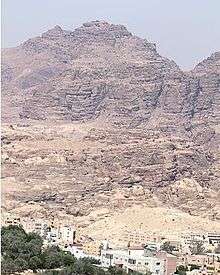Horites
_p061_MT.HOR_TO_RIVER_ARNON_-_ARABIA_PETRAEA_IN_THE_SOUTH_COUNTRY.jpg)
The Horites, (Hebrew: Horim, חרי) were a people mentioned in the Torah (Genesis 14:6, 36:20, Deuteronomy 2:12) inhabiting areas around Mount Seir which was in Canaan (Gen. 36:2,5).[1][2]
Name
Mt. Seir seems to have been named after one Seir, who the land of the Horites - "the land of Seir" - was named after (Genesis 14:6). He was the ancestor of the Horite chiefs listed in Genesis 36:20f. The Horites have been identified with references in Egyptian inscriptions to Khar (formerly translated as Harri), which concern a southern region of Canaan.[3] Despite the widespread influence of the Hurrians, a more northern people, these were probably not the same as the Horites.
History
The first mention of the Horites in the Torah was when they were defeated by a coalition of Eastern kings led by the Kedorlaomer of Elam (in modern Iran). These kings had come through the Horite territory to subdue a rebellion by a coalition of other 'kings' of peoples whom they had ruled for twelve years, who were living near the Dead Sea and Sodom and Gomorrah (Genesis 14:1-12).
Later, according to Genesis 36, the Horites co-existed and inter-married with the family of Esau, grandson of Abraham through Isaac (Genesis 25:21-25). They were eventually brought under the rule of the descendants of Esau, also then known as Edom.


The ancestry of Seir the Horite is not specified. Pre-Edomite Horite chiefs, descendants of Seir, are listed in Gen. 36:20-29 and 1 Chronicles 1:38-42. One of these chiefs, Zibeon, is also described as a Hivite. Esau's wife Oholibamah was his granddaughter (Oholibamah bat Anah ben Zibeon ben Seir)(Gen. 36:2,24,25). Their three sons all became 'chiefs,' although unlike other sons of Esau, they are not called chiefs "in Edom." (compare Gen. 36:16, 17 with 36:18). This may indicate a transition time in which only certain Horite areas were becoming known as Edom.
The chiefs who descended from Esau are listed in Gen 36:40-43. Two of these chiefs would appear to have been female - Timna and Oholibamah.
At some time, certain of these leaders rose to the level of 'kings' over the other chiefs, and the Horite land became known as Edom rather than the land of Seir. One example of these kings is Jobab, son of Zerah, a son of Esau and his wife Basemath, who was Ishamel's daughter (Genesis 36:35). Another is a ‘Temanite’, Husham (Genesis 36:34), a descendant of Esau's son, Teman (Gen. 36:10,11).
None of these kings' sons became kings after their fathers died. Apparently, there was no familial royal line whereby sons of these post-Horite kings succeeded to the throne, but rather, some other system was in place by which kings were either chosen or won the right to rule (Genesis 36:31-29).
By the time governance of these peoples had been consolidated under kings instead of chiefs, Horites are no longer mentioned as such. The land of Seir had become known as Edom.
References
- ↑ Horite]s at International Standard Bible Encyclopedia.
- ↑ 32 The name Horite in the Bible.
- ↑ James Orr, The International standard Bible encyclopedia, (1915) page 1421.